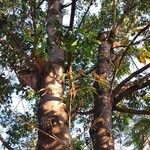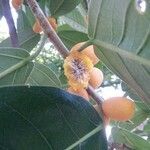Trees, 25-30 m tall, d.b.h. 40-90 cm. Bark gray, smooth. Branchlets green, ca. 1 cm thick, pubescent. Stipules 2-3 cm, thickly leathery, with gray silky hairs. Petiole robust, 2-5 cm; leaf blade broadly ovate to broadly ovate-elliptic, 10-19 × 8-11 cm, thickly leathery, glabrous, base broadly cuneate, margin entire, apex obtuse, acute; basal lateral veins long, secondary veins 5-7 on each side of midvein, reticulate venation clearly defined in dry leaf. Figs axillary on leafy branchlets, paired, red or yellow when mature, ellipsoid-ovoid, 1.7-2.8 cm, sometimes pubescent when very young, glabrous when mature, apical pore navel-like, convex, sessile; involucral bracts hoodlike, covering young fig, caducous, apex broadly obtuse, scar ringlike. Male, gall, and female flowers within same fig. Male flowers: scattered; calyx lobes 4, transparent, membranous; stamen 1. Gall flowers: sepals 4; style subapical, long. Female flowers: sessile; sepals 4; style elongated. Achenes tuberculate. Fl. Mar-Apr, fr. May-Jul.
A fig. It is a large tree. The trunk has buttresses. It grows 30 m tall and has a spreading crown. It is a stranger fig starting attached to other plants then sending down roots to allow the tree to grow independently. The bark is smooth and grey. The leaves are alternate and narrowly oval. They are 10 cm long by 4 cm wide. The flowers occur singly or in pairs in the axils of leaves. The fruit or figs are orange-red and 2.5 cm long. They have many seeds.










